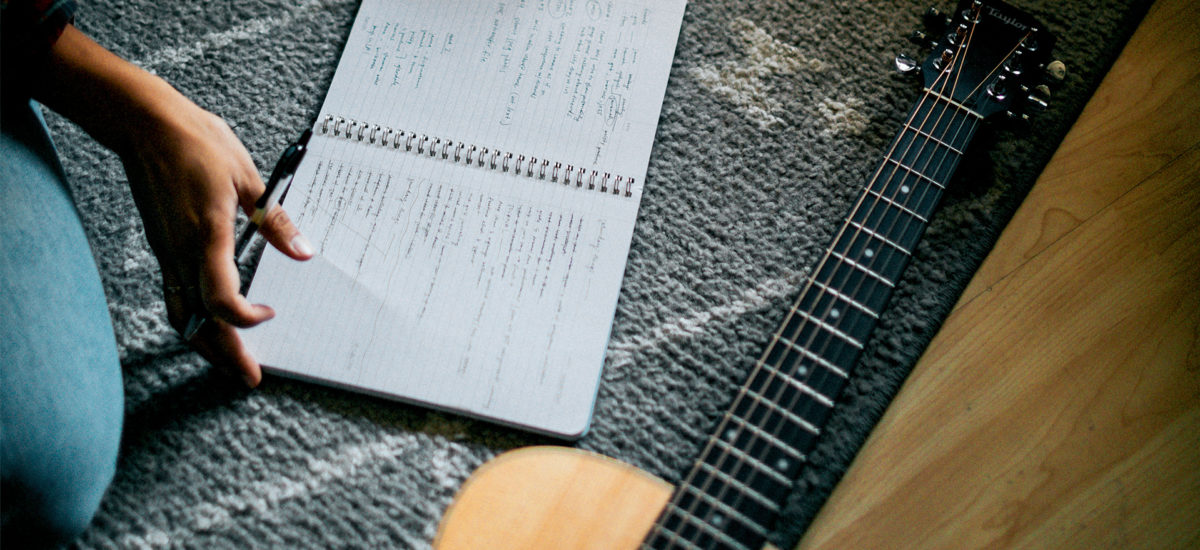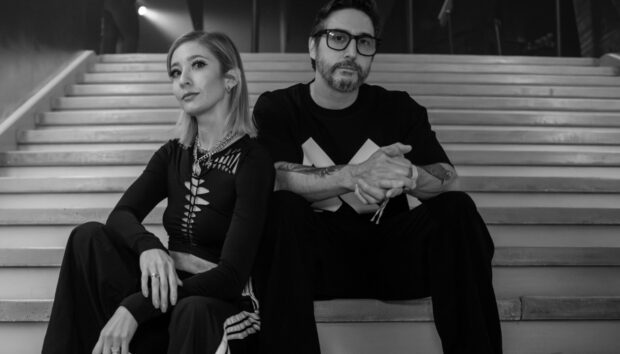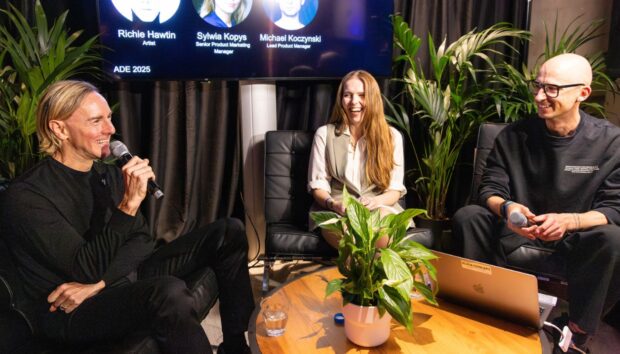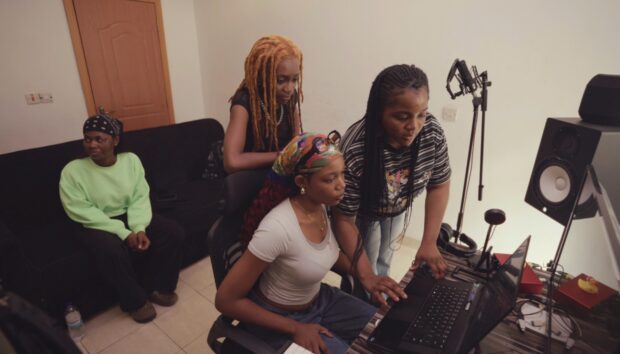
The word “music” derives from the Ancient Greek mousike, meaning ‘of the Muses’. The Muses were goddesses who inspired people in their explorations of science and the arts, believed to be the source of creativity and knowledge. The process of writing a song has a strange, almost mystical quality to it, in that more often than not it feels like the inspiration hits you suddenly from somewhere external, and the artist is more a conduit channeling an idea than its actual originator. You can’t have a good idea just because you want to, but you can build up a workflow so you’re ready to go when the moment hits. Read on for an entry-level outline of what you need to get started writing a song, a breakdown of the basic musical components, and some helpful songwriting tips to get the creative juices flowing.Naturally, the primary tools are your ears and your imagination. You might often catch yourself singing or composing in your head spontaneously, but the tricky part is how to get this music out of your mind and into the real world. Many musicians write at the piano or with a guitar in hand so they can noodle away, test out chords, and improvise an accompaniment to the melodies in their thoughts. These days, computer software makes it possible to lay down multiple tracks quickly and easily. DAWs, or Digital Audio Workstations, are like a full professional recording studio inside your computer, offering an abundance of tools to sketch out more complex ideas and help writing a song. Plugging in a MIDI keyboard gives you the playing range of a traditional piano with access to more varied sounds from software synths and effects plug-ins.
If you are more drawn to rock or folk styles and getting creative on the guitar, then programs like Guitar Rig are an excellent and affordable toolbox for diversifying your sound. Without shelling out loads of money on physical equipment, you can emulate a wide range of different amp sounds, from glossy, clean tones to aggressive distortion via old-school ‘50s fuzz. Then you can set up a whole virtual pedalboard with different effects, faithfully reproducing a live stage set-up with none of the wiring or hassle. Alternatively, you might want a backing beat from a drum machine that you can play along to. Pad controllers like Maschine are great for this, allowing you to tap in a beat on the fly, waste no time getting distracted with programming, and stay focused on writing a hit song.
Of course, writing a song is not an exact science, and a project often morphs through various iterations with elements being cut and added along the way. Think of an initial idea as nothing more than a spark to get you going, and don’t be too precious or protective of any single element. This is the whole magic of songwriting: creating a whole greater than the sum of its parts. There’s a kind of sleight of hand at play, as listeners hear not the individual parts but the overall whole in a single, blended sound. So go with the flow, try not to limit or pigeonhole yourself too much, and let the songwriting guide you like the ancient Muses.

Steps to Writing a Song
There are as many different ways of writing a song as there are songs in the world, the process being deeply personal and unique to the individual. That said, we can look at the fundamentals and take some songwriting tips from the musical greats. In its most basic form, songwriting comprises the disciplines of composing music and writing lyrics. Some songwriters choose to create a piece of instrumental music first then add the words, while others prefer to pen a text or poem then set it to a melody. A helpful tip for writing a song is to use placeholder lyrics while you concentrate on building the tune. These can be gibberish at first, and you never know – you might just come up with some abstract poetry in the process.
Think about the overall theme or message you wish to communicate. A song is an opportunity to tell a story, so what do you want to say? It can be difficult to know how to start writing a song, so try just brainstorming random ideas and word associations around your chosen theme and see what comes up. You could reflect on a positive experience in your life as a source of inspiration, or draw on negative feelings instead and flip them into something beautiful. This can be a very cathartic and healing experience, and is one of the main motivations driving artists forward in their work: creating something beneficial out of the struggle of living.
Bob Dylan, regarded as one of the greatest songwriters of all time, is perhaps even more acclaimed for his lyrics than his music. His songs became the soundtrack to countercultural protest movements in the 1960s, featuring stark, powerful, political lyrics. In contrast, Kurt Cobain famously wrote the words for Nirvana hits at the very last minute, on the way to the recording sessions. This casual, throwaway approach was a big part of the band’s appeal, and gave their lyrics an obscurity and dreamlike immediacy that has had fans and critics scratching their heads ever since, trying to interpret (or perhaps misinterpret) what they mean.
In the pop music industry, different people often specialize in different elements of the song. For example, beat-makers produce a musical bed or backing beat, while someone else focuses on writing a top-line melody or hook that will stick in peoples’ memories. Some believe there is a kind of golden formula to writing a hit song with that enigmatic x-factor and the potential to break through to the masses. But just as often, forcing it and trying too hard to make a masterpiece can itself be an obstacle to the flow of creativity.
The narrative arc of the lyrics tends to correspond to the structure of the song itself. A good intro is important, as it grabs the listener’s attention and establishes the mood for the rest of the song. Think of the distinctive hits of the Rolling Stones: from the very first lick of the guitar, you know who it is, you’re pulled into the groove, and you get an idea of where the song is going. Most popular songs follow a conventional verse-chorus structure, in which the repeating chorus is the main event, the climax of the song featuring the central statement of the lyrics (and usually the title of the song). The verses allow space for more exposition and detail in the story, and these two main parts play off each other, the verses adding emphasis and building up to the release of the chorus. The bridge or middle-eight is an intriguing section; occurring only once, typically late in the song, it provides a moment of musical contrast before returning to the main chorus motif one final time. The outro can serve to neatly tie up the piece, or the song can simply fade out to silence, which gives the impression of a longer jam that could be extended in the context of a live version.
When writing a song, you could start off with the intro, laying out a catchy hook and progressing from there in a linear fashion from start to finish. The other option is to write the main chorus section first and build your song around this. If you are working with electronic music in a DAW, it can be productive to set a short loop and layer up the busiest, most intense part of the track first, after which you can decide the arrangement by a process of subtraction. Also, remember to use a few songs you love as references. This can help you get close to the sound you are hoping to achieve, while demystifying the task of layering instrument tracks and arranging the sections of the song. This isn’t plagiarism, simply taking inspiration. After all, every song ever written is, to a greater or lesser extent, a composite of influences from previous works. Referencing other pieces of music can spur on ideas and give you tips for writing a song yourself. How closely you follow the formula set by previous songs, or else diverge from it towards something more original, is completely up to you. Some amount of familiarity can give your song that pop sensibility which makes it catchy and appealing to listeners, but by experimenting with changing things up or straight-up throwing the rulebook out the window, you can discover more out-there and boundary-pushing song ideas.

When You Need A Bit Of Songwriting Help…
With all the songwriting tips and the best will in the world, making music is not always easy; some days it just doesn’t happen. Navigating periods of writer’s block or hitting a dead end in a project are struggles that more or less every musician faces at some point. There are a few things you can try to relieve this if you feel like you’re banging your head against a wall, such as turning a page with a fresh project or approaching a song from a different angle. For instance, if you normally start with the top-line or lyrics, why not try building a backing beat first? Or try experimenting with a radically different tempo, instrument, or song structure than you are used to. Stepping out of your comfort zone can be creatively stimulating; change gears, change tack, and see if it gets you out of a temporary rut.
Another potential antidote to a lack of inspiration is collaboration. Sometimes you’ve played a song on repeat so many times you can barely hear it anymore, so bringing in some fresh ears and a fresh opinion can be very valuable and illuminating. Moreover, it is productive (although sometimes painful) to get feedback from people whose musical taste you trust. Seeing how others react to your work can help you realize which ideas are worth pursuing further and which you might be better off dropping, at least for now.
There have been many famous and fruitful songwriting collaborations over the years, from Lennon-McCartney to ABBA’s Benny Andersson and Björn Ulvaeus. A curious example is the partnership of Elton John and Bernie Taupin, where the writing of music and lyrics was completely split. The two met after both being unsuccessful in an audition in 1967. John told the receptionist that he couldn’t write lyrics, and he was handed an envelope of Taupin’s poems, which he put to his own music with no further interaction between the two. Later, their working relationship got closer, but it acts as a good example that there is no single, universal technique for writing a good song.
An even more elaborate case is that of Kanye West. The rap superstar is famous for getting together large groups of artists and creatives from across the world and the musical universe. West favors writing a song in this communal way, filling a studio with talent and thereby creating the environment where creativity flourishes organically. Often the focus is much broader than specifically songwriting or recording, with more abstract or conceptual ideas thrown into the melting pot at these exclusive creative happenings.
But we need not get ahead of ourselves or think too big in the early stages; writing and recording a rough demo mix is an achievement in itself. Keep in mind that big hits often come from unexpected places, and in music as in the arts in general, perfection can be found in imperfection. Mistakes and happy accidents can be springboards for new ideas, and imperfection is what gives a piece its character and humanity. Refer to the rules and conventions of writing a song but do not feel bound by them. Creativity is all about getting into an open, receptive frame of mind; creativity is, above all, freedom.















